Charles E W Bean, Diaries, AWM38 3DRL 606/275/1 - 1918 - 1938 - Part 18
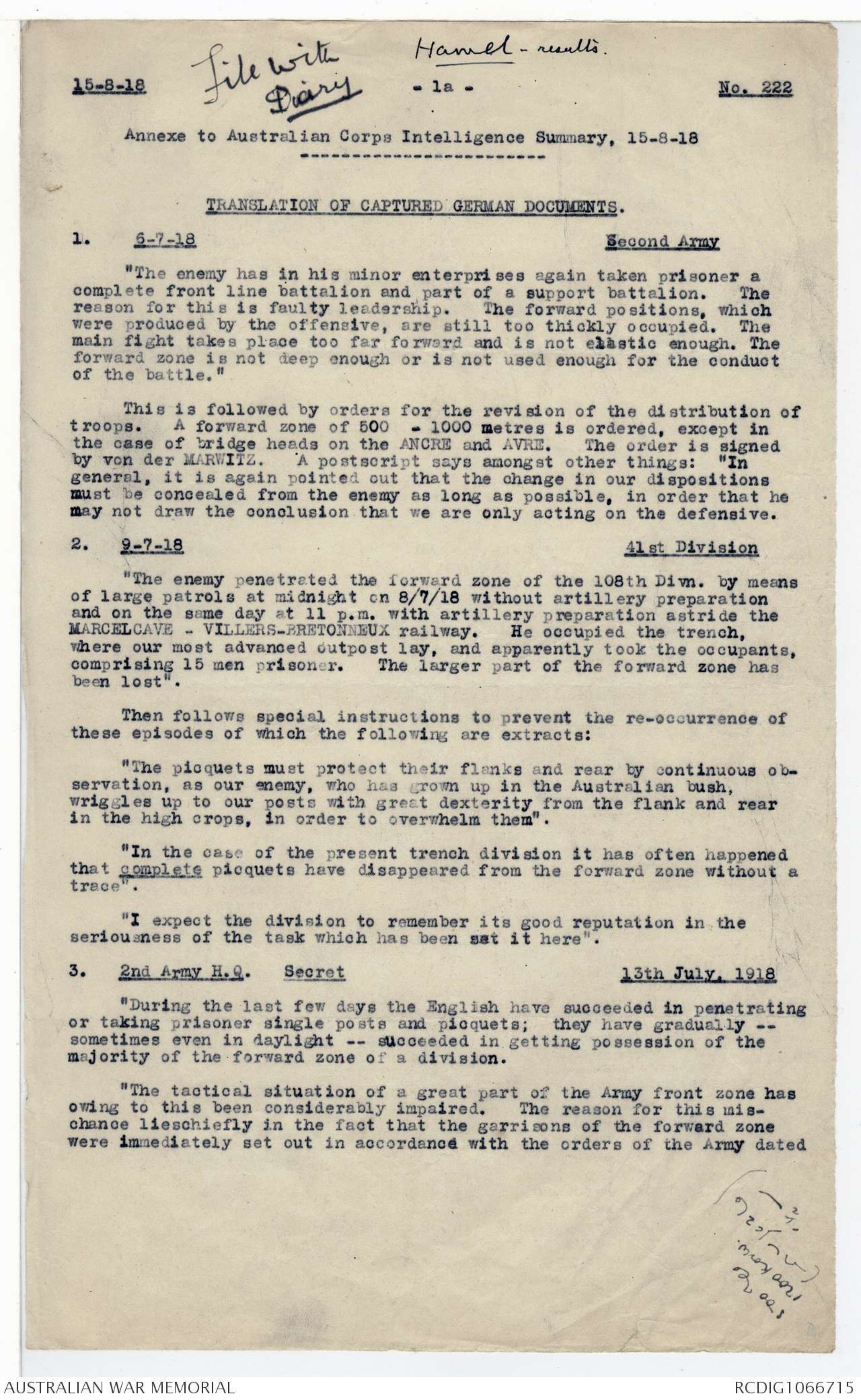

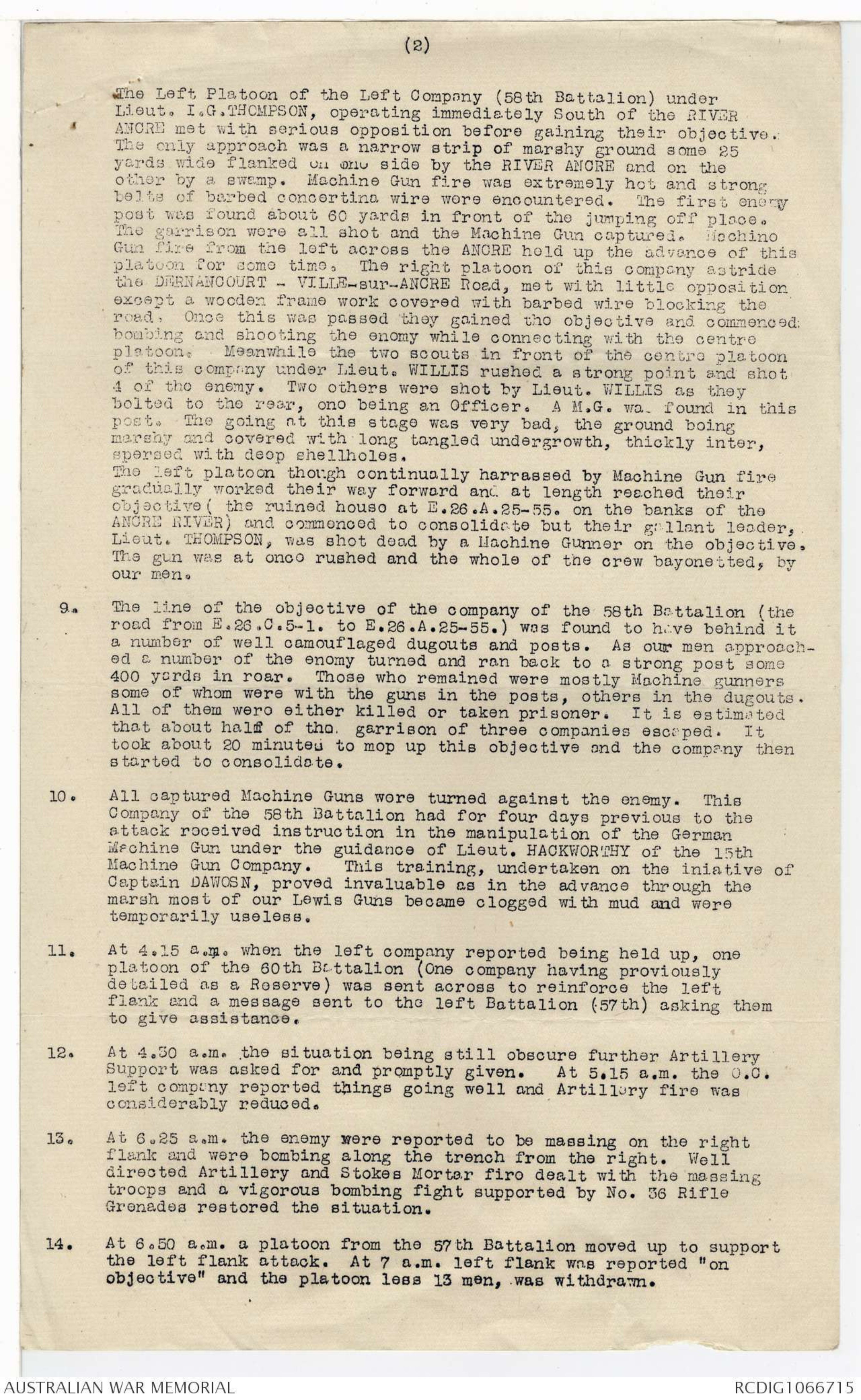
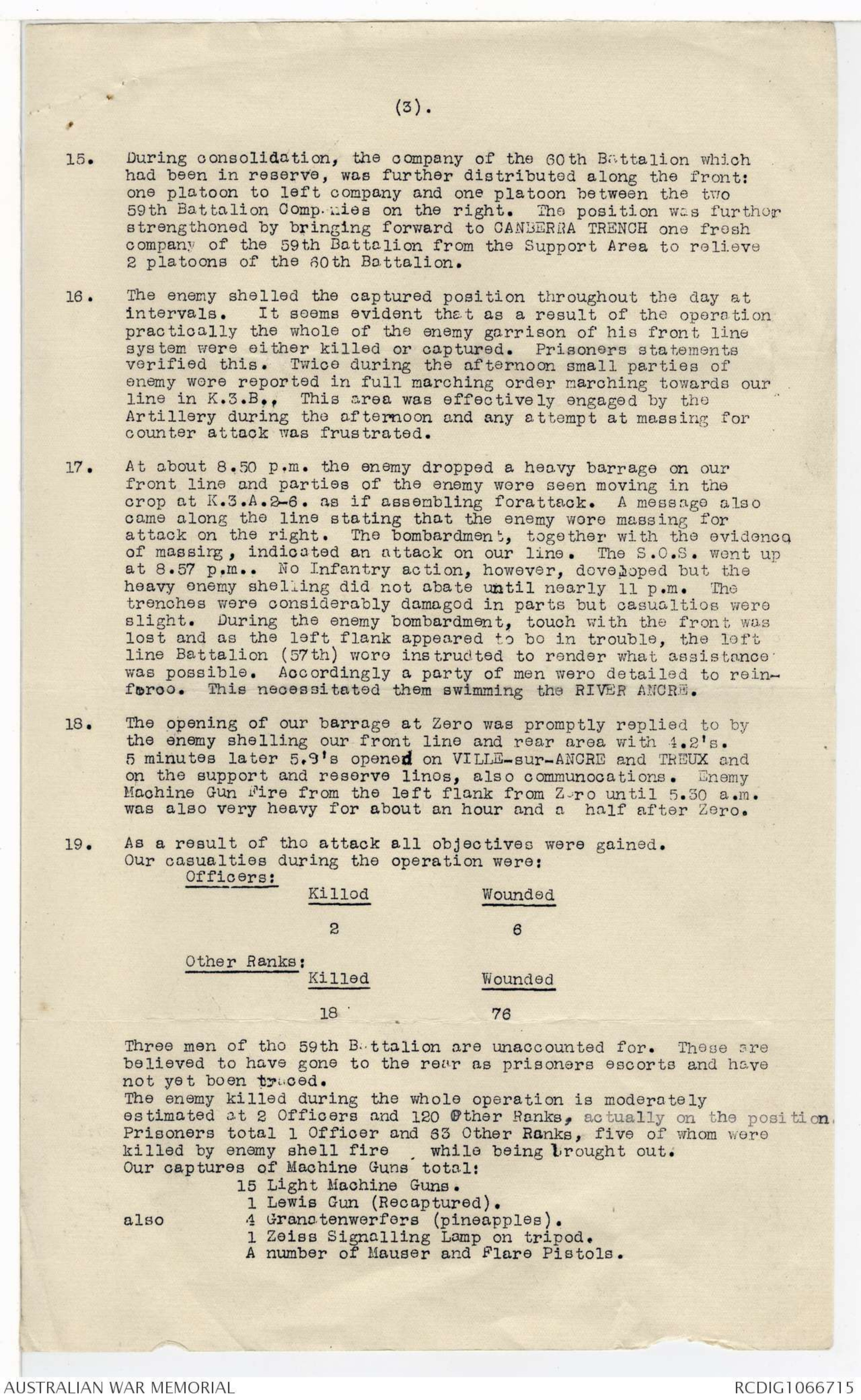
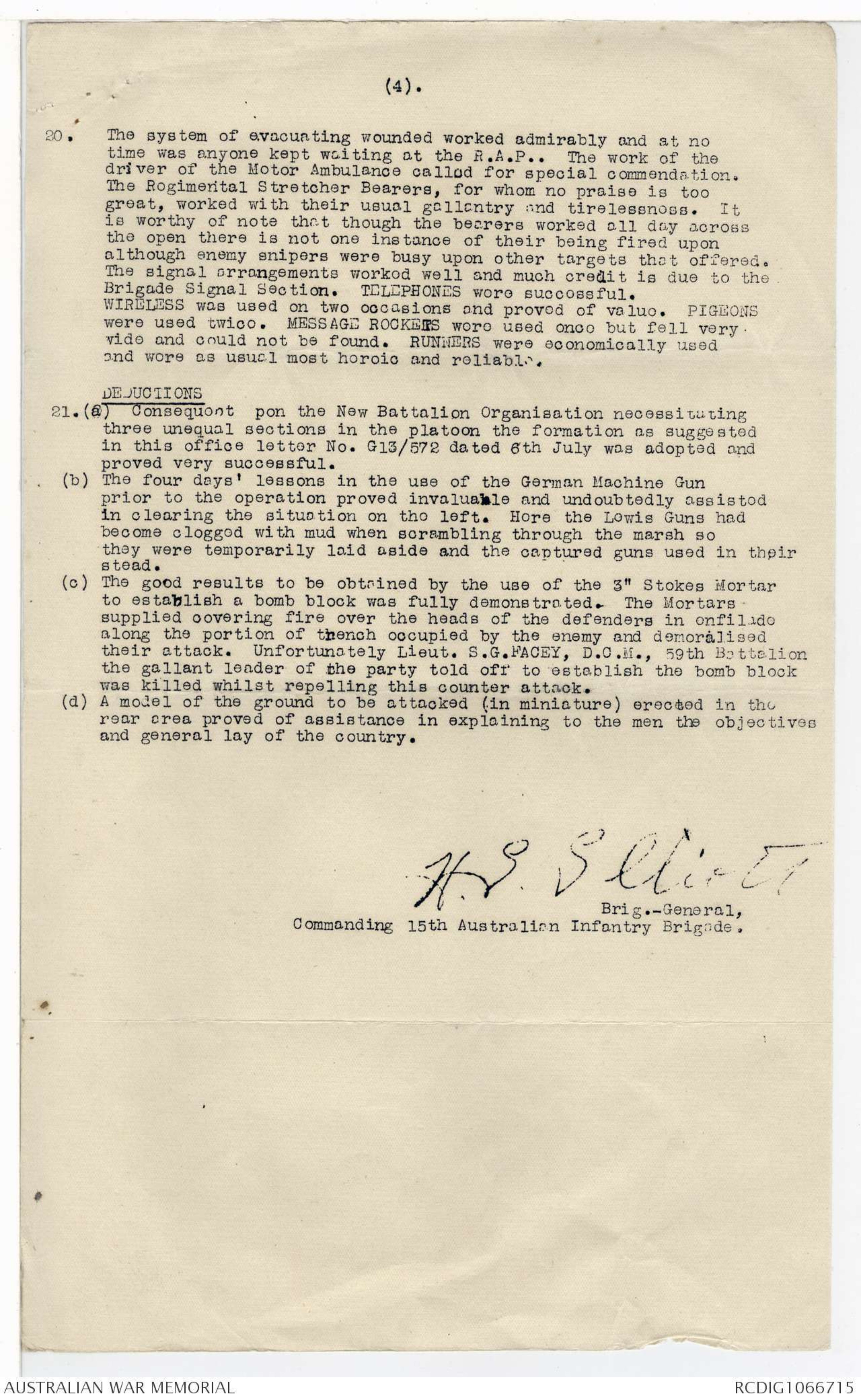
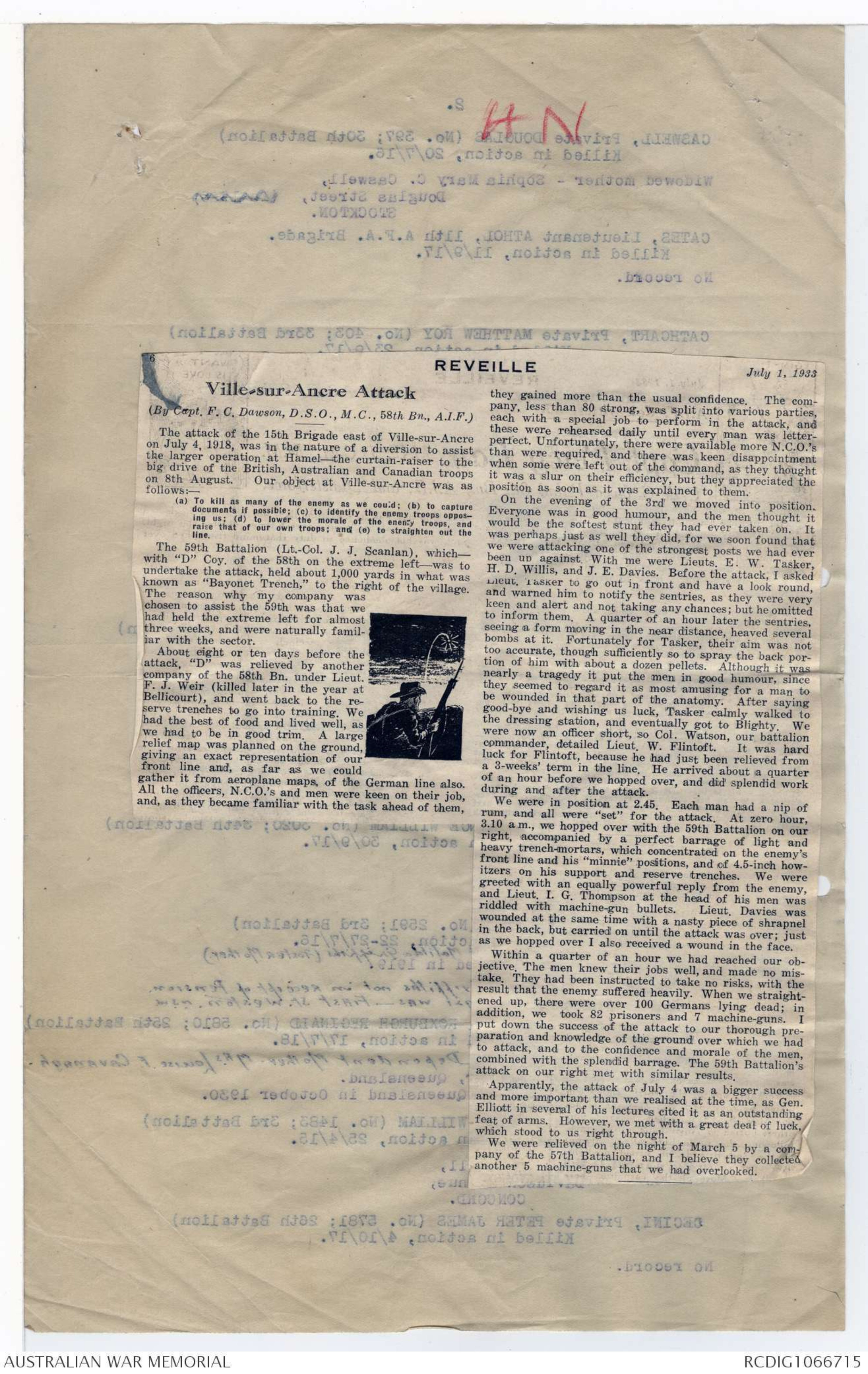
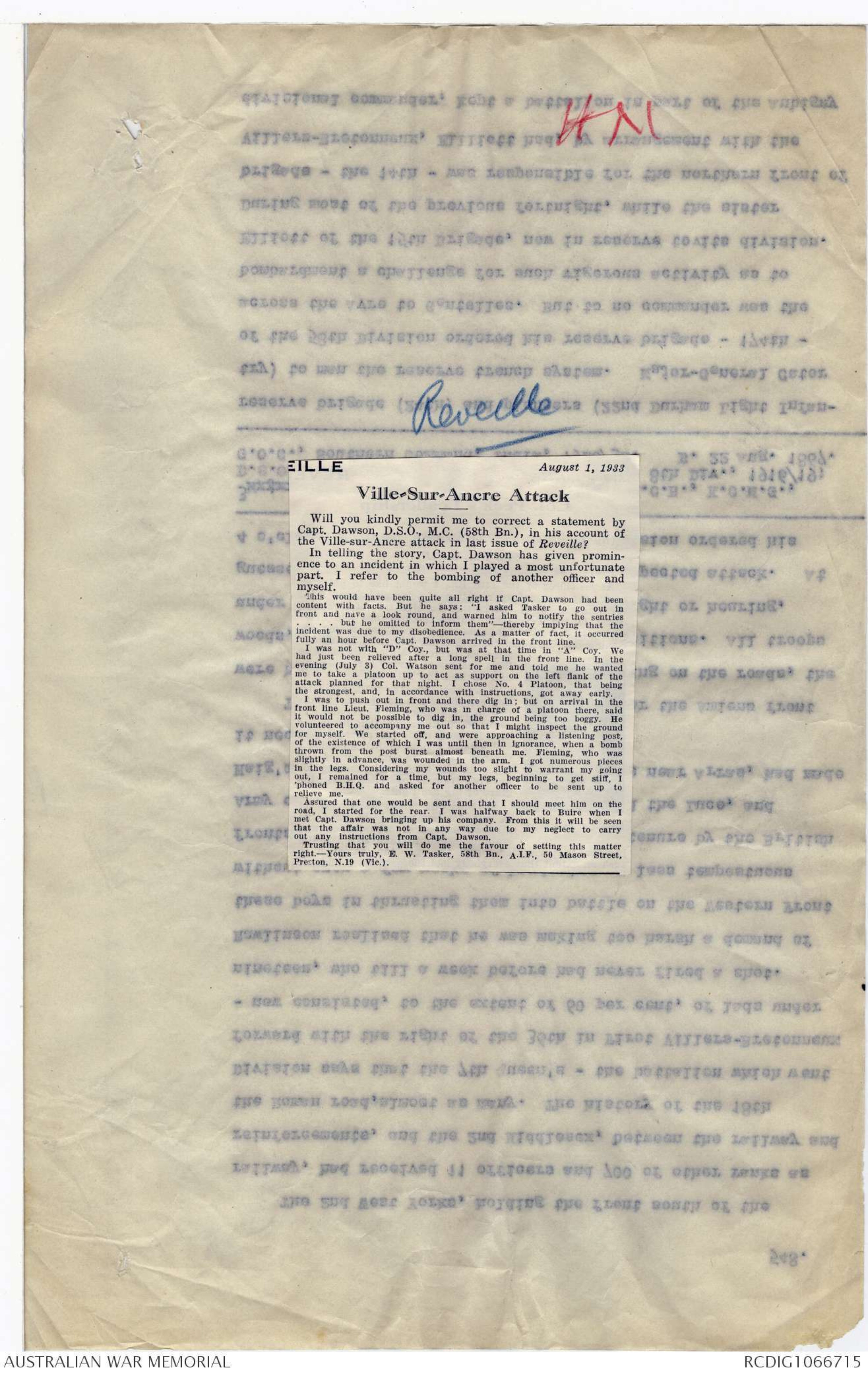

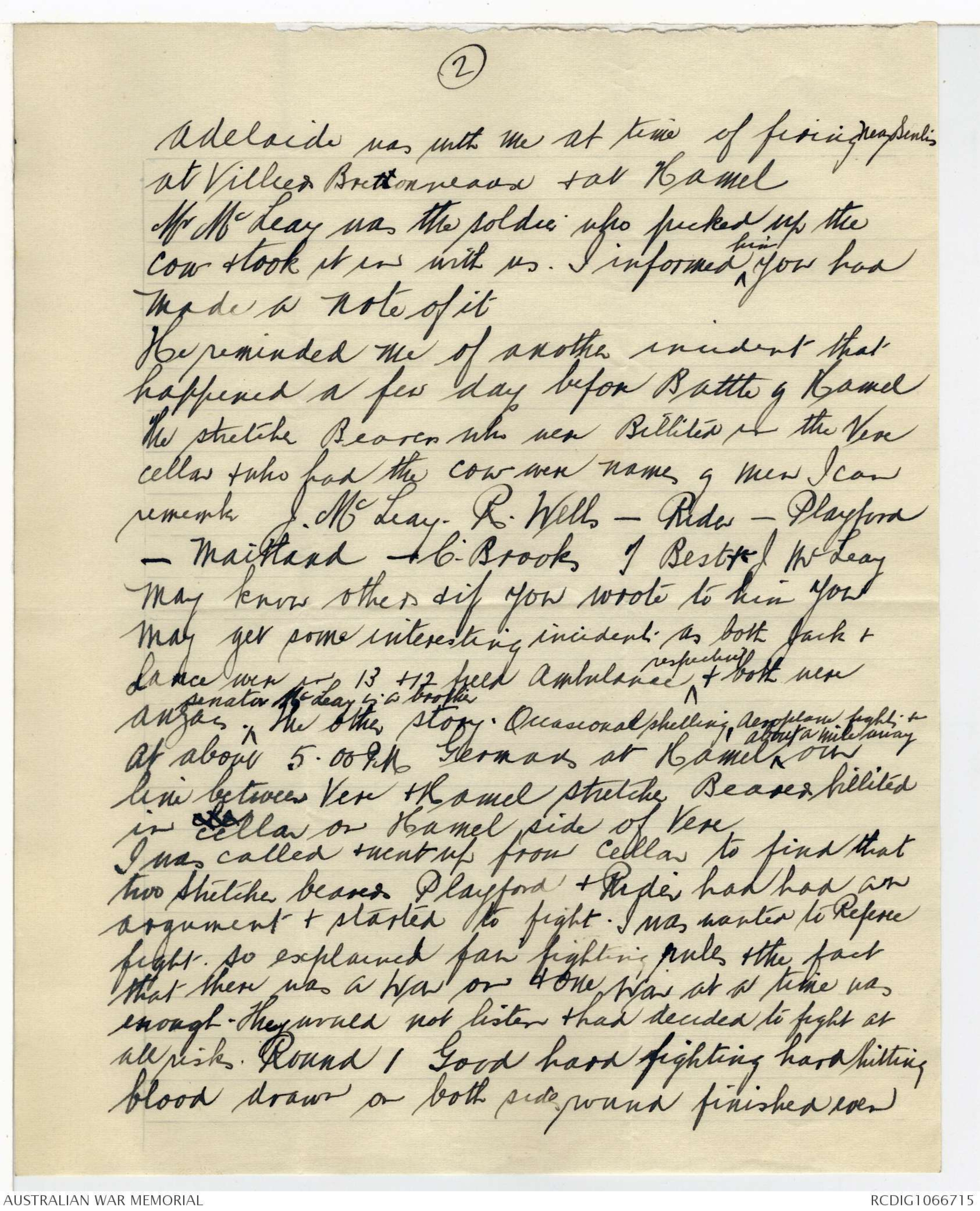
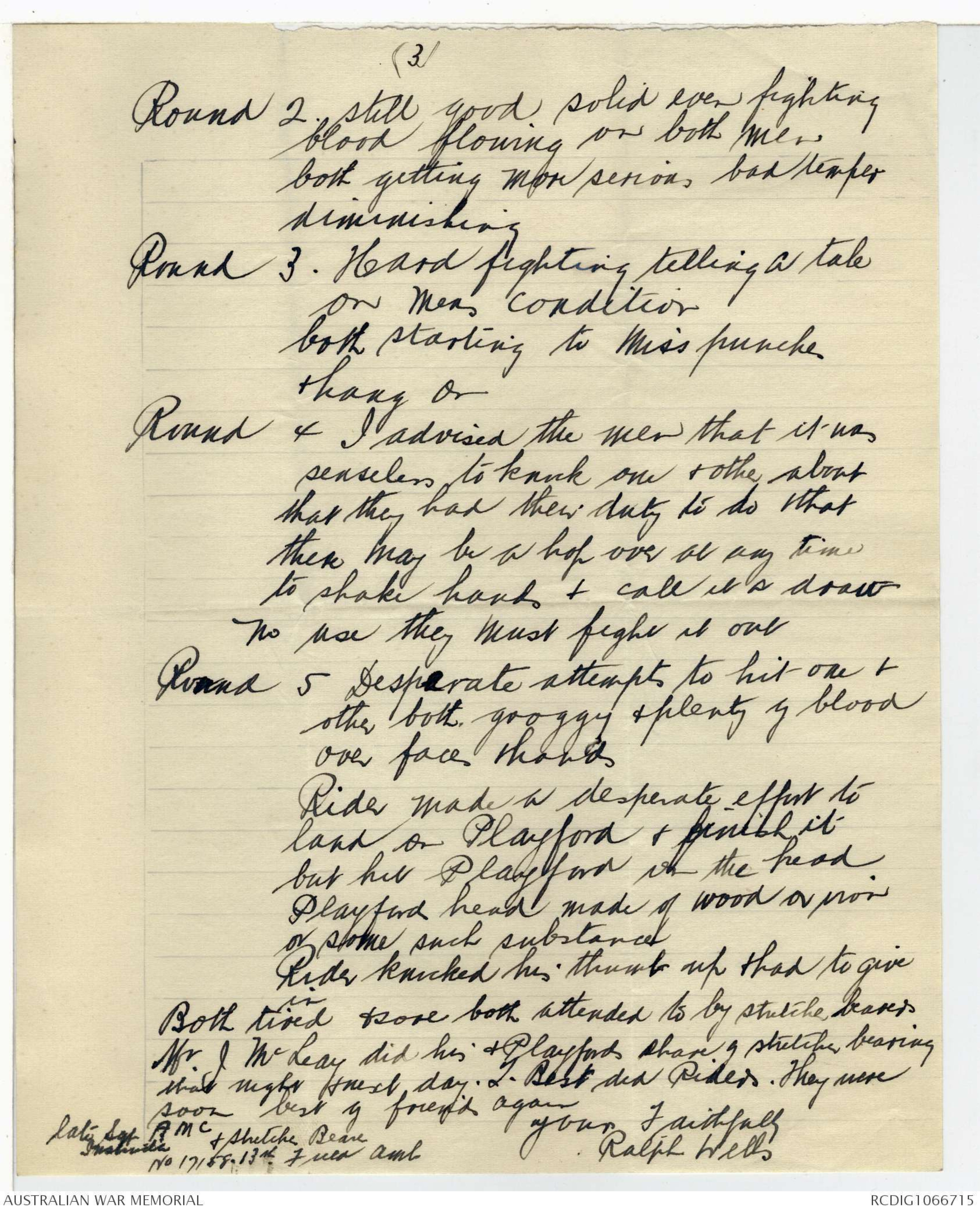
Hamel - results
15.8.18 [*File with Diary*] -1a- No. 222
Annexe to Australian Corps Intelligence Summary, 15.8-18
TRANSLATION OF CAPTURED GERMAN DOCUMENTS.
1. 6-7-18 Second Army
"The enemy has in his minor enterprises again taken prisoner a
complete front line battalion and part of a support battalion. The
reason for this is faulty leadership. The forward positions, which
were produced by the offensive, are still too thickly occupied. The
main fight takes place too far forward and is not elastic enough. The
forward zone is not deep enough or is not used enough for the conduct
of the battle."
This is followed by orders for the revision of the distribution of
troops. A forward zone of 500 - 1000 metres is ordered, except in
the case of bridge heads on the ANCRE and AVRE. The order is signed
by von der MARWITZ. A postscript says amongst other things: "In
general, it is again pointed out that the change in our dispositions
must be concealed from the enemy as long as possible, in order that he
may not draw the conclusion that we are only acting on the defensive.
2. 9-7-18 4lst Division
"The enemy penetrated the forward zone of the 108th Divn. by means
of large patrols at midnight on 8/7/18 without artillery preparation
and on the same day at 11 p.m. with artillery preparation astride the
MARCELCAVE - VILLERS-BRETONNEUX railway. He occupied the trench,
where our most advanced outpost lay, and apparently took the occupants,
comprising 15 men prisoner. The larger part of the forward zone has
been lost".
Then follows special instructions to prevent the re-occurrence of
these episodes of which the following are extracts:
"The picquets must protect their flanks and rear by continuous observation,
as our enemy, who has grown up in the Australian bush,
wriggles up to our posts with great dexterity from the flank and rear
in the high crops, in order to overwhelm them".
"In the case of the present trench division it has often happened
that complete picquets have disappeared from the forward zone without a
trace."
"I expect the division to remember its good reputation in the
seriousness of the task which has been set it here".
3. 2nd Army H.Q . Secret 13th July, 1918
"During the last few days the English have succeeded in penetrating
or taking prisoner single posts and picquets; they have gradually --
sometimes even in daylight -- succeeded in getting possession of the
majority of the forward zone of a division.
"The tactical situation of a great part of the Army front zone has
owing to this been considerably impaired. The reason for this mischance
lieschiefly in the fact that the garrisons of the forward zone
were immediately set out in accordance with the orders of the Army dated
[*500 [shorthand]
1200Koner
(shorthand)
½ (shorthhand)*]
Headquar ters,
15th Australian Infantry Brigade,
6th July, 1918.
Headquarters,
5th Australian Division,
Report on Operation Carried out East of VILLS-sur-ANCRE,
July, 5th 1918.
I have to report as follows on the operation carried out by Units of
this Brigade against the enemy line East of VILLE-sur-ANCRE on July
5th, 1918.
BRIEF RECOUNTAL OF PLAN:
1. In conjunction with a Major Operation taking place South of the
SOMME, the 15th Australian Infantry Brigade was ordered to attack
and capture the enemy trench between K.2.A.10-20. on the South and
the RIVER ANCRE on tho North (E.26.A.3-6).
2. The objects of the operation were:
(a) In conjunction with other minor operations along the
Divisional front to create a diversion for the operation
taking place South of the RIVER SOMME.
(b)To improve our observation along the MORLANCOURT VALLEY.
(c) To improve our position respecting the initial stages
of any future operations.
(d) To kill or capture as many of the enemy as possible.
3. (a) Troops allotted to carry out the operation were:
(i) Two Companies 59th Battalion.
(ii) One Company 58th Battalion.
(iii) One Company 60th Battalion and One Platoon 58th Battalion
(to be made available for repelling counter attack if
required).
(b) Lieut.Col. J.J.SCANLAN, D.S.O. Commanding 59th Battalion was
placed in charge.
4. The operation was supported by Artillery, Medium and Light Trench
Mortar and Machine Gun fire. Detailed tasks for these weapons
were as shown on sketch and Appendix No. 1. accompanying Brigade
Order No. 172 attached. The 8th A.L.T.M.B. was attached for the
operation, making a total of 16 Light Trench Mortars.
5. Detailed Instructions as to method of attack are as shown in
Orders of O.C. Attack appended hereto.
6. As a preliminary preparation two saps were dug forward from our
front line, the right sap at K.1.D.60-95. was dug to give a suitable
defensive flank to the South. The left sap at K.l.B.65-75.
was to be dug through towards enemy sap head at K.2.B. 05-58. as
a main communication sap. On Zero day the sap heads had reached
K.1.D.80-95. and K.l.B.95-60. respectively.
RECOUNTAL OF EVENTS.
7. Zero time was 3.10 a.m. on the 4th July. The approach march of the
two companies of the 59th Battalion was commenced from the Support
Area at 11.30 p.m. and the attackers assembled in our front line
trench opposite the objoctive. The jumping off tape was laid out
at 12.30 p.m. and from that time onwards to Zero minus 10 monutes
protective patrols were kept out in front. Guides led the attackers
onto the tapes and by 3.5 a.m. all companies had signalled "Ready"
8. The barrage opened precisely at 3.10 a.m.. At 3.50 a.m. the first
prisoners came in and it was then ascertained that the two right
(59th) companies had gained their objectives at 3.30 a.m.. A prearranged
signal to denote objective gained had been sent up but
owing to dust and smoke it could not be soen.
(2)
The Left Platoon of the Left Company (58th Battalion) under
Lieut. I.G.THOMPSON, operating immediately South of the RIVER
ANCRE met with serious opposition before gaining their objective.
The only approach was a narrow strip of marshy ground some 25
yards wide flanked on one side by the RIVER ANCRE and on the
other by a swamp. Machine Gun fire was extremely hot and strong
belts of barbed concertina wire wore encountered. The first enemy
post was found about 60 yards in front of the jumping off place.
The garrison were all shot and the Machine Gun captured. Machine
Gun fire from the left across the ANCRE held up the advance of this
platoon for some time. The right platoon of this company astride
the DERNANCOURT - VILLE-sur-ANCRE Road, met with little opposition
except a wooden frame work covered with barbed wire blocking the
road. Once this was passed they gained the objective and commenced
bombing and shooting the enemy while connecting with the centre
platoon. Meanwhile the two scouts in front of the centre platoon
of this company under Lieut. WILLIS rushed a strong point and shot
4 of the enemy. Two others were shot by Lieut. WILLIS as they
bolted to the rear, one being an Officer. A M.G. wa. found in this
post. The going at this stage was very bad, the ground being
marshy and covered with long tangled undergrowth, thickly
interspersed with deep shellholes.
The left platoon though continually harrassed by Machine Gun fire
gradually worked their way forward and at length reached their
objective( the ruined house at E.28.A.25-55. on the banks of the
ANCRE RIVER) and commenced to consolidate but their gallant leader,
Lieut. THOMPSON, was shot dead by a Machine Gunner on the objective.
The gun was at once rushed and the whole of the crew bayonetted, by
our men.
9. The line of the objective of the company of the 58th Battalion (the
road from E.26.C.5-1. to E.26.A.25-55.) was found to have behind it
a number of well camouflaged dugouts and posts. As our men approached
a number of the enemy turned and ran back to a strong post some
400 yards in rear. Those who remained were mostly Machine gunners
some of whom were with the guns in the posts, others in the dugouts.
All of them were either killed or taken prisoner. It is estimated
that about half of the garrison of three companies escaped. It
took about 20 minutes to mop up this objective and the company then
started to consolidate.
10. All captured Machine Guns were turned against the enemy. This
Company of the 58th Battalion had for four days previous to the
attack received instruction in the manipulation of the German
Machine Gun under the guidance of Lieut. HACKWORTHY of the 15th
Machine Gun Company. This training, undertaken on the iniative of
Captain DAWOSN, proved invaluable as in the advance through the
marsh most of our Lewis Guns became clogged with mud and were
temporarily useless.
11. At 4.15 a.m. when the left company reported being held up, one
platoon of the 60th Battalion (One company having previously
detailed as a Reserve) was sent across to reinforce the left
flank and a message sent to the left Battalion (57th) asking them
to give assistance.
12. At 4.30 a.m. the situation being still obscure further Artillery
Support was asked for and promptly given. At 5.15 a.m. the O.C.
left company reported things going well and Artillery fire was
considerably reduced.
13. At 6.25 a.m. the enemy were reported to be massing on the right
flank and were bombing along the trench from the right. Well
directed Artillery and Stokes Mortar fire dealt with the massing
troops and a vigorous bombing fight supported by No. 36 Rifle
Grenades restored the situation.
14. At 6.50 a.m. a platoon from the 57th Battalion moved up to support
the left flank attack. At 7 a.m. left flank was reported "on
objective" and the platoon less 13 men, was withdrawn.
(3).
15. During consolidation, the company of the 60th Battalion which
had been in reserve, was further distributed along the front:
one platoon to left company and one platoon between the two
59th Battalion Companies on the right. The position was further
strengthened by bringing forward to CANBERRA TRENCH one fresh
company of the 59th Battalion from the Support Area to relieve
2 platoons of the 60th Battalion.
16. The enemy shelled the captured position throughout the day at
intervals. It seems evident that as a result of the operation
practically the whole of the enemy garrison of his front line
system were either killed or captured. Prisoners statements
verified this. Twice during the afternoon small parties of
enemy wore reported in full marching order marching towards our
line in K.3.B.. This area was effectively engaged by the
Artillery during the afternoon and any attempt at massing for
counter attack was frustrated.
17. At about 8.50 p.m. the enemy dropped a heavy barrage on our
front line and parties of the enemy were seen moving in the
crop at K.3.A.2-6. as if assembling forattack. A message also
came along the line stating that the enemy were massing for
attack on the right. The bombardment, together with the evidence
of massing, indicated an attack on our line. The S.O.S. went up
at 8.57 p.m.. No Infantry action, however, developed but the
heavy enemy shelling did not abate until nearly 11 p.m. The
trenches were considerably damaged in parts but casualties were
slight. During the enemy bombardment, touch with the front was
lost and as the left flank appeared to be in trouble, the left
line Battalion (57th) were instructed to render what assistance
was possible. Accordingly a party of men were detailed to reinforce.
This necessitated them swimming the RIVER ANCRE.
18. The opening of our barrage at Zero was promptly replied to by
the enemy shelling our front line and rear area with 4.2's.
5 minutes later 5.9's opened on VILLE-sur-ANCRE and TREUX and
on the support and reserve lines, also communications. Enemy
Machine Gun Fire from the left flank from Zero until 5.30 a.m.
was also very heavy for about an hour and a half after Zero.
19. As a result of the attack all objectives were gained.
Our casualties during the operation were:
Officers:
Killed Wounded
2 6
Other Ranks:
Killed Wounded
18 76
Three men of the 59th Battalion are unaccounted for. These are
believed to have gone to the rear as prisoners escorts and have
not yet been traced.
The enemy killed during the whole operation is moderately
estimated at 2 Officers and 120 Other Ranks, actually on the position.
Prisoners total 1 Officer and 63 Other Ranks, five of whom were
killed by enemy shell fire while being brought out.
Our captures of Machine Guns total:
15 Light Machine Guns.
1 Lewis Gun (Recaptured).
also 4 Granatenwerfers (pineapples).
1 Zeiss Signalling Lamp on tripod.
A number of Mauser and Flare Pistols.
(4).
20. The system of evacuating wounded worked admirably and at no
time was anyone kept waiting at the R.A.P.. The work of the
driver of the Motor Ambulance called for special commendation.
The Regimental Stretcher Bearers, for whom no praise is too
great, worked with their usual gallantry and tirelessness. It
is worthy of note that though the bearers worked all day across
the open there is not one instance of their being fired upon
although enemy snipers were busy upon other targets that offered.
The signal arrangements worked well and much credit is due to the
Brigade Signal Section. TELEPHONES were successful.
WIRELESS was used on two occasions and proved of value. PIGEONS
were used twice. MESSAGE ROCKETS were used once but fell very
wide and could not be found. RUNNERS were economically used
and were as usual most heroic and reliable.
DEDUCTIONS
21. (a) Consequent pon the New Battalion Organisation necessitating
three unequal sections in the platoon the formation as suggested
in this office letter No. G13/572 dated 6th July was adopted and
proved very successful.
(b) The four days' lessons in the use of the German Machine Gun
prior to the operation proved invaluable and undoubtedly assisted
in clearing the situation on the left. Here the Lewis Guns had
become clogged with mud when scrambling through the marsh so
they were temporarily laid aside and the captured guns used in their
stead.
(c) The good results to be obtained by the use of the 3” Stokes Mortar
to establish a bomb block was fully demonstrated. The Mortars
supplied covering fire over the heads of the defenders in enfilade
along the portion of trench occupied by the enemy and demoralised
their attack. Unfortunately Lieut. S.G.FACEY, D.C.M., 59th Battalion
the gallant leader of the party told off to establish the bomb block
was killed whilst repelling this counter attack.
(d) A model of the ground to be attacked (in miniature) erected in the
rear area proved of assistance in explaining to the men the objectives
and general lay of the country.
H.E. Elliot
Brig.-General,
Commanding 15th Australian Infantry Brigade.
[*HN*]
REVEILLE
July 1. 1933
Ville-sur- Ancre Attack
(By Capt. F. C. Dawson, D.S.O.,M.C., 58th Bn. A.l.F.)
The attack of the 15th Brigade east of Ville-sur-Ancre
on July 4, 1918, was in the nature of a diversion to assist
the larger operation at Hamel -the curtain-raiser to the
big drive of the British, Australian and Canadian troops
on 8th August. Our object at Ville-sur-Ancre was as
follows:
(a) To kill as many of the enemy as we could: (b) to capture
documents if possible: (c) to identify the enemy troops opposing
us; (d) to lower the morale of the enemy troops, and
raise that of out own troops; and (e) to straighten out the
line.
The 59th Battalion (Lt-Col. J. J. Scanlan), which-
with "D" Coy, of the 58th on the extreme left- was to
underbake the attack, held about 1,000 yards in what was
known as "Bayonet Trench," to the right of the village.
The reason why my company was
chosen to assist the 59th was that we
had held the extreme left for almost
three weeks, and were naturally familiar
with the sector.
About eight or ten days before the
attack, "D" was relieved by another
company of the 58th Bn. under Lieut.
F. J. Weir (killed later in the year at
Bellicourt), and went back to the reserve
trenches to go into training. We
had the best of food and lived well, as
we had to be in good trim. A large
relief map was planned on the ground,
giving an exact representation of our
front line and, as far as we could
gather it from aeroplane maps of the German line also.
All the officers, N.CO's and men were keen on their job,
and, as they became familiar with the task ahead of them,
they gained more than the usual confidence. The company,
less than 80 strong, was split into various parties,
each with a special job to perform in the attack, and
these were rehearsed daily until every man was letter-
perfect. Unfortunately, there were available more N.C.O.'s
than were required, and there was, keen disappointment
when some were left out of the command, as they thought
it was a slur on their efficiency, but they appreciated the
position as soon as it was explained to them.
On the evening of the 3rd we moved into position.
Everyone was in good humour, and the men thought it
would be the softest stunt they had ever taken on. It
was perhaps just as well they did, for we soon found that
we were attacking one of the strongest posts we had ever
been up against. With me were Lieuts. E. W. Tasker
H.D. Willis, and J.E. Davies. Before the attack, I asked
Lieut. Tasker to go out in front and have a look round,
and warned him to notify the sentries, as they were very
keen and alert and not taking any chances; but he omitted
to inform them. A quarter of an hour later the sentries,
seeing a form moving in the near distance, heaved several
bombs at it. Fortunately for Tasker, their aim was not
too accurate, though sufficiently so to spray the back portion
of him with about a dozen pellets. Although it was
nearly a tragedy it put the men in good humour, since
they seemed to regard it as most amusing for a man to
be wounded in that part of the anatomy. After saying
good-bye and wishing us luck, Tasker calmly walked to
the dressing station, and eventually got to Blighty. We
were now an officer short, so Col. Watson, our battalion
commander, detailed Lieut. W. Flintoft. It was hard
luck for Flintoft, because he had just been relieved from
a 3-weeks' term in the line. He arrived about a quarter
of an hour before we hopped over, and did splendid work
during and after the attack.
We were in position at 2.45. Each man had a nip of
rum, and all were "set" for the attack. At zero hour,
3.10 am, we hopped over with the 59th Battalion on our
right, accompanied by a perfect barrage of light and
heavy trench-mortars, which concentrated on the enemy's
front line and his "minnie" positions, and of 4.5-inch howitzers
on his support and reserve trenches. We were
greeted with an equally powerful reply from the enemy,
and Lieut I. G. Thompson at the head of his men was
riddled with machine gun bullets. Lieut. Davies was
wounded at the same time with a nasty piece of shrapnel
in the back, but carried on until the attack was over; just
as we hopped over I also received a wound in the face.
Within a quarter of an hour we had reached our objective.
The men knew their jobs well, and made no mistake.
They had been instructed to take no risks, with the
result that the enemy suffered heavily. When we straightened
up, there were over 100 Germans lying dead; in
addition, we took 82 prisoners and 7 machine-guns. I
put down the success of the attack to our thorough preparation
and knowledge of the ground over which we had
to attack, and to the confidence and morale of the men,
combined with the splendid barrage. The 59th Battalion's
attack on our right met with similar results.
Apparently, the attack of July 4 was a bigger success
and more important than we realised at the time, as Gen.
Elliott in several of his lectures cited it as an outstanding
feat of arms. However, we met with a great deal of luck,
which stood to us right through.
We were relieved on the night of March 5 by a company
of the 57th Battalion, and I believe they collected
another 5 machine guns that we had overlooked.
[*HN*]
Reveille
August 1, 1933
Ville-Sur- Ancre Attack
Will you kindly permit me to correct a statement by
Capt. Dawson, D.SO. M.C. (58th Bn.), in his account of
the Ville-sur-Ancre attack in last issue of Reveille?
In telling the story. Capt. Dawson has given prominence
to an incident in which I played a most unfortunate
part. I refer to the bombing of another officer and
myself.
This would have been quite all right if Capt Dawson had been
content with facts. But he says "I asked Tasker to go out in
front and have a look round, and warned him to notify the sentries
. . . . but he omitted to inform them"- thereby implying that the
incident was due to my disobedience. As a mater of fact, it occurred
fully an hour before Capt. Dawson arrived in the front Mne.
I was not with D Coy., but was at that time with "A" Coy. We
had just been relieved after a long spell in the front line. In the
evening (July 3) Col. Watson sent for me and told me he wanted
me to take a platoon up to act as support on the left flank of the
attack planned for that night. I chose No. 4 Platoon, that being
the strongest, and, in accordance with instructions, got away early
I was to push out in front and there dig in; but on arrival in the
front line Lieut. Fleming, who was in charge of a platoon there, said
it would not be possible to dig in, the ground being too boggy. He
volunteered to accompany me out so that I might inspect the ground
for myself. We started of, and were approaching a listening post,
of the existence of which I was until then in ignorance, when a bomb
thrown from the post burst almost beneath me. Fleming, who was
slightly in advance, was wounded in the arm. I got numerous pieces
in the legs. Considering my wounds too slight to warrant my going
out, I remained for a time, but my legs, beginning to get stiff, I
'phoned B.H.Q. and asked for another officer to be sent up to
relieve me.
Assured that one would be sent and that I should meet him on the
road, I started for the rear. I was halfway back to Buire when I
met Capt. Dawson bringing up his company. From this it will be seen
that the affair was not in any way due to my neglect to carry
out any Instructions from Capt. Dawson.
Trusting that you wilI do me the favour of setting this matter
right-Yours truly, W. Tasker, 58th Bn. A.I.F. 50 Mason Street,
Preston, N.19 (Vic.).
1
"Janar"
80 Sea View Road
Henley Beach South Aust
5/4/35
Dr Bean
Commonwealth Historian
Sydney
Dear Dr Bean. I have had a talk with General
Leane since I returned from Sydney also to soldier
mates who were with me at time I witnessed the advance
of Australian Battalion firing on what looked to
us to be the advancing Germans. General Leane
explained to me that they the 48th had gone on
from Senlis at 9.00AM in the morning. I am not sure
about the time but I am beginning to think
it was earlier in the day than I first thought
at any rate what we did see was an Australian
Battalion rapid firing at advancing men
It must have been us you say; the time some
Tommies retreating in front of the advancing
German men fired on by our chaps who
thought they were advancing Germans.
General Leane will be in Sydney shortly and
states he will call on you.
He is a fine soldier & gentleman. He went to a
lost of trouble to understand me and explain the
situation. Mr. J McLeay Merchant of Grenfell Street
2
Adelaide was with me at time of firing near Senlis
at Villers Brettoneaux & at Hamel
Mr McLeay was the soldier who picked up the
cow & took it in with us. I informed ^ him you had
made a note of it.
He reminded me of another incident that
happened a few days before Battle of Hamel
The stretcher bearers who were Billeted in the Vere
cellar & who had the cow were names g men I can
remember J. McLeay. R .Wells - Rider - Playford
- Maitland - C. Brooks of best to J McLeay
may know others & if you wrote to him you
may get some interesting incidents. As both Jack &
Lance were in 13 & 12 field ambulance ^ respectively & both were
anzacs ^ Senator McLeay is a brother. The other story. Occasional shelling, aeroplane fights
at about 5.00 PM Germans at Hamel ^about a mile away our
line between Vere & the Hamel stretcher Bearers billeted
in cellar xxx cellar on Hamel side of Vere
I was called & went up from cellar to find that
two stretcher bearers Playford & Ryder had had an
argument & started to fight. I was wanted to Referee
fight. So explained fair fighting rules & the fact
that there was a war on & one war at a time was
enough. They would not listen & had decided to fight at
all risks. Round 1 Good hard fighting hard hitting
blood drawn on both sides round finished even
(3)
Round 2. still good solid even fighting
blood flowing on both men
both getting more serious bad temper
diminishing
Round 3. Heard fighting telling a tale
on mens condition
both starting to miss punches
& hang on
Round 4 I advised the men that it was
senseless to knock one & other about
that they had their duty to do that
there may be a hop over at any time
to shake hands & call it a draw
no use they must fight it out
Round 5 Desperate attempts to hit one &
other both groggy & plenty of blood
over faces & hands
Rider made a desperate effort to
land on Playford & finish it
but hit Playford on the head
Playford head made of wood or iron
or some such substance
Rider knicked his thumb up & had to give
Both tired & sire both attended to by stretcher bearers
Mr J McLeay did his & Playfords share of stretcher bearing
that night & next day T. Best did Riders. They were
soon best of friends again
[*late Sgt AMC & stretcher bear
Invincible no. 17188. 13th Field Amb*]
yours Faithfully
Ralph Wells
 Maralyn K
Maralyn KThis transcription item is now locked to you for editing. To release the lock either Save your changes or Cancel.
This lock will be automatically released after 60 minutes of inactivity.